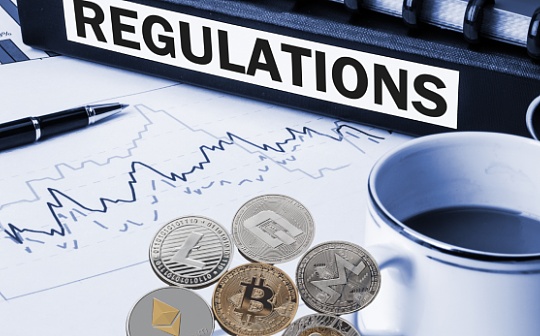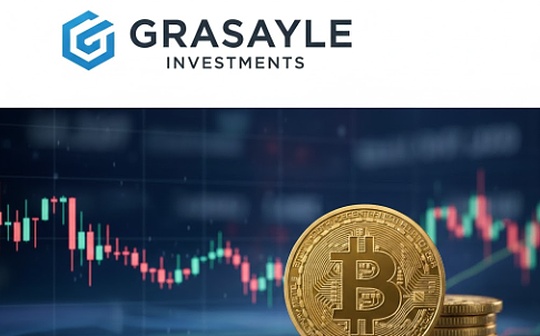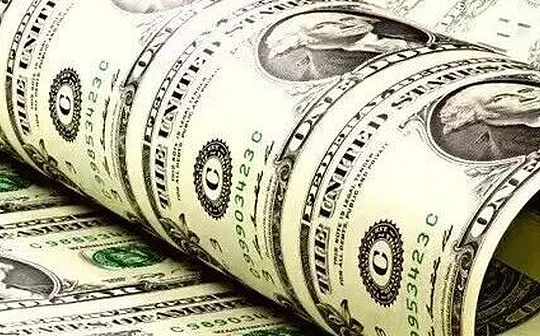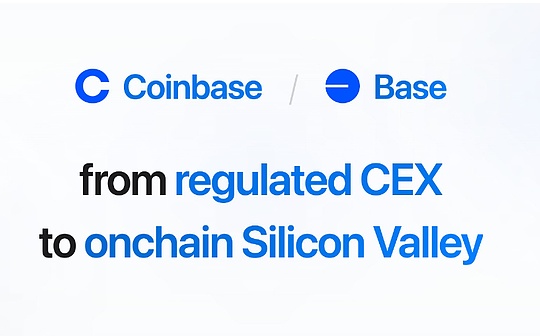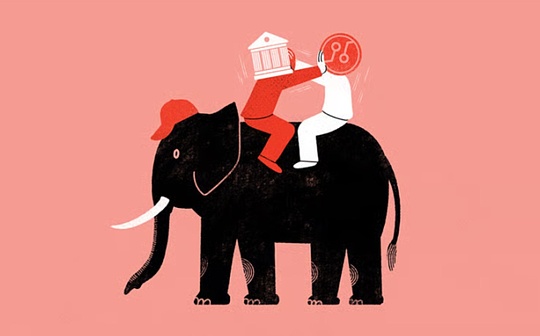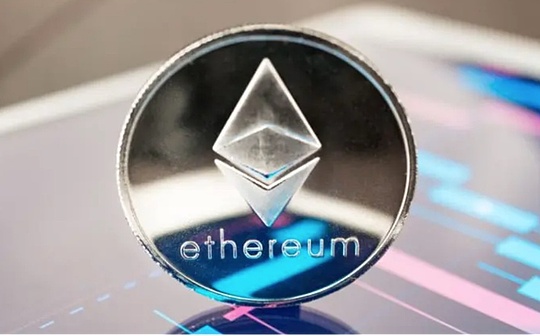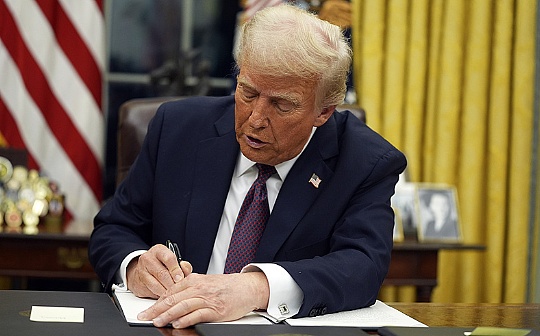
Written by: Deng Tong, Bitchain Vision
On the morning of March 7, 2025, Beijing time, the United States officially established its strategic Bitcoin reserve.
David Sacks, White House director of artificial intelligence and cryptocurrency, said U.S. President Donald Trump signed an executive order early on March 7 to build a strategic Bitcoin reserve that will initially come from assets seized by the government.
What is the executive order for Trump’s strategy Bitcoin reserves
Trump’s executive order will establish two different digital asset storage mechanisms: Bitcoin strategic reserves and digital asset reserves.The Bitcoin strategic reserve will contain about 200,000 BTC obtained through criminal and civil confiscation, and the government is authorized to explore ways to obtain more Bitcoin without increasing the burden on taxpayers; the digital asset reserve will contain other digital assets such as XRP, ADA, ETH and SOL, but the government will not actively seek to purchase these assets.
Saxophone and Forbes reporter Eleanor Terrett both interpreted the policy.
David Sacks:
“Just a few minutes ago, President Trump signed an executive order to build strategic Bitcoin reserves.
The reserve will be capitalized on federally owned Bitcoins that were confiscated as part of a criminal or civil asset forfeiture process.This means it won’t cost taxpayers a penny.
It is estimated that the U.S. government owns approximately 200,000 bitcoins; however, no full audit has been conducted.The executive order directs a comprehensive accounting of federal government digital asset holdings.
The United States will not sell any Bitcoin deposited in reserves.It will be retained as a store of value.For cryptocurrencies commonly known as “digital gold”, reserves are like a digital Fort Knox.
The premature sale of Bitcoin has cost U.S. taxpayers more than $17 billion in value.Now the federal government will develop a strategy to maximize the value it holds.
The Treasury Secretary and Commerce Secretary are authorized to develop budget-neutral strategies to acquire more bitcoin provided that these strategies do not increase the cost of U.S. taxpayers.
also,The executive order also established a U.S. digital assets reserve that includes digital assets other than Bitcoin confiscated in criminal or civil lawsuits.
The government will not acquire other assets for the reserve pool except for the assets acquired through the confiscation process.
The purpose of the reserve library is to manage government digital assets under the leadership of the Ministry of Finance.
The promise has been fulfilled
President Trump pledged to build a strategic Bitcoin reserve and digital asset reserve pool.These promises have been fulfilled.
The executive order underlines President Trump’s commitment to building the United States into the “crypto-city capital of the world.”
I want to thank the President for his leadership and vision in supporting this cutting-edge technology and his rapid execution in supporting the digital asset industry.His government is indeed moving forward at the “technological speed”.
I also want to thank the President’s Digital Asset Markets Task Force – in particular Treasury Secretary Scott Becent and Commerce Secretary Howard Lutnik for their help and support in completing this work.Finally, Beau Hines played a key role as the Executive Director of our Working Group.”
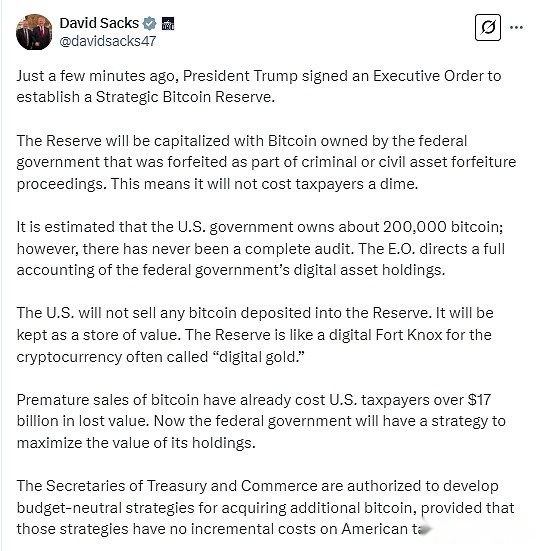
Forbes reporter Eleanor Terrett posted on X platform:
Therefore, @realDonaldTrumpThe executive order requires two things – strategic reserves and inventory.
The strategic reserve will contain only $BTC (the digital asset with the most store of value), using approximately 200,000 tokens held by the government over the years through criminal and civil forfeiture.Sacks said Bessent and Lutnick were also authorized to explore ways to get more bitcoin by not spending taxpayer costs.
The executive order also requires a comprehensive audit of all digital assets currently held by the government.
Another is the inventory of digital assets, which contains assets other than Bitcoin—presumably $XRP, $ADA, $ETH and $SOL (as the president announced last weekend) and other possible assets.
The main difference between reserves and inventory is that the government does not proactively look for ways to buy more assets in the inventory.It will only explore using government funds (if they can find a budget-neutral way to do this) to buy $BTC.
Sax said the purpose of the reserve is to “responsibly manage government digital assets under @USTreasury’s leadership.”
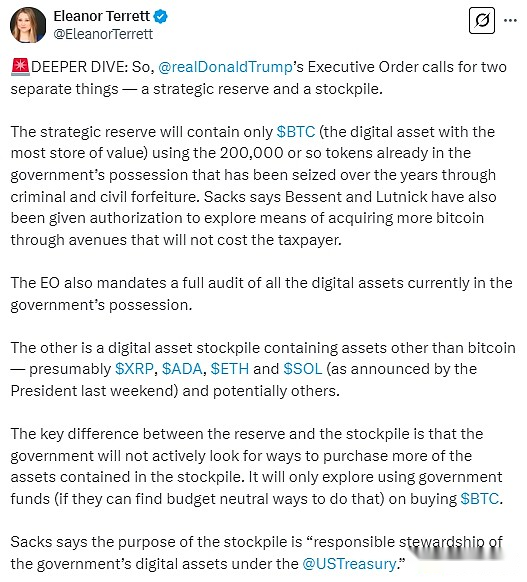
All the good news?Bitcoin is temporarily falling
After the announcement of Trump’s signing of the strategic Bitcoin reserve executive order, the crypto market did not rebound significantly.BTC even fell below $90,000. As of press time, BTC was at $87,172.24, a day-to-day drop of 3.6%.
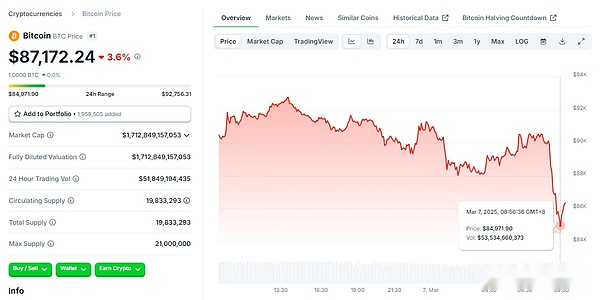
Really good?Bitcoin arms race between countries is coming
Matt Hougan, Chief Investment Officer, BitwisePost a comment saying,In the long run, this is extremely beneficial for Bitcoin.“Strategic Bitcoin reserves have the following effects: 1) It greatly reduces the possibility that the US government will one day “ban” Bitcoin;2)Greatly increase the possibility of other countries establishing strategic Bitcoin reserves;3)Speed up other countries to consider building strategic Bitcoin reserves, because it creates a short-term window for countries to seize potential additional purchases from the United States; 4) makes it more difficult for institutions (from national account consulting platforms to quasi-governmental agencies such as the International Monetary Fund) to position Bitcoin as some dangerous or inappropriate asset.”
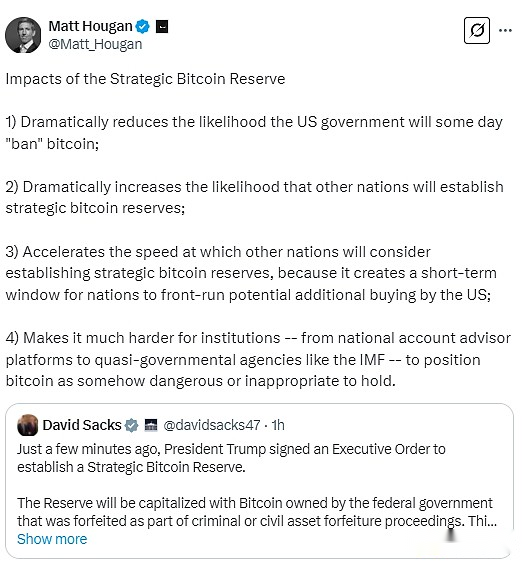
Ryan Rasmussen, head of research at Bitwise, said: The United States has just established a strategic Bitcoin reserve, calling it “digital fort Knox of digital gold.”China is now more likely to hold 200,000 bitcoins they own.What about the UK?Russia?Japan?This is just the beginning.
Some industry insiders believe that it is not important how the market reacts.This will trigger an arms race to acquire more bitcoins.First the United States, then other countries.This is extremely beneficial in the long run.Keep hoarding and stay humble.
Coinbase Director Conor GroganPosted on social media,“By my estimate, the U.S. government holds 198,109 bitcoins. This executive order will reduce the selling pressure of about $18 billion.”
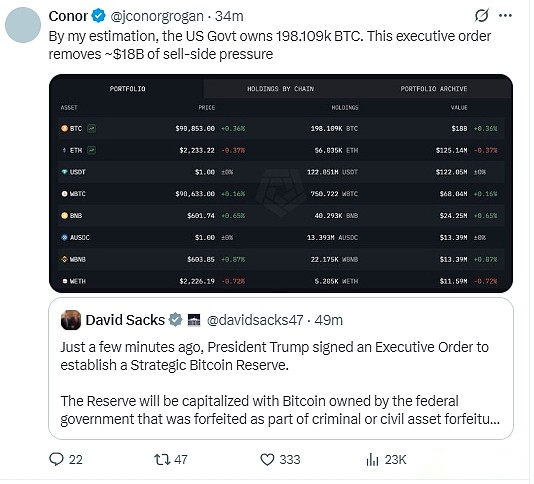
Previously, according to JPMorgan, the U.S. strategic cryptocurrency reserves are less than 50% likely to be approved, and tokens like XRP, Solana (SOL) and Cardano (ADA) are likely to not be included.Nikolaos Panigirtzoglou, managing director of global market strategy at JPMorgan Chase, said in an interview:“We believe that the approval of the US strategic cryptocurrency reserve is not the most likely scenario (assuming Congressional approval is required). Therefore, we think it is less than 50% likely.”
More information can be viewed“Trump’s two tweets to save the market, is the US’s strategic cryptocurrency reserve really coming?”
Recent stress on the crypto market
1. The risk of US recession puts pressure on crypto assets
Crypto macro analyst Noelle Acheson said, “The spread between the 10-year U.S. Treasury yield and the 3-month Treasury yield has turned negative again, causing the yield curve to invert, suggesting that the U.S. economy could fall into recession, i.e., GDP contracted for two consecutive quarters. This is usually not a good signal. We are still dealing with the battle between different narratives – on the one hand, risk aversion sentiment may put pressure on Bitcoin (BTC) and other crypto assets for some time due to macroeconomic uncertainty. But on the other hand, the ‘safe haven’ narrative is strengthening, and the positive news from the White House further highlights the amazing shift in official attitudes.”
Bloomberg dollar index fell for the fourth consecutive day, setting the longest consecutive decline since September 2024The Trump administration said tariffs on the US-Mexico-Canada Agreement covering goods and services were suspended until April 2.The euro narrowed its gains after the European Central Bank cut interest rates as scheduled, but suggested that the rate cut could be nearing its end.The Bloomberg dollar index fell 0.2%, and fell 0.4% during the session; the index fell 2.2% in four days, moving towards its worst single-week performance since November 2022, and the non-farm employment report will be released on Friday.
JPMorgan strategists warnIts forecast for the gains of the U.S. stock market at the beginning of the year is at risk of failure.JPMorgan Chase maintained its forecast for the S&P 500 end-of-year target of 6,500 points, but warned that the forecast had “large standard errors.”This target position means that the S&P 500 still has about 13% upside from Thursday’s closing level of 5738.52 points.“It is possible that the S&P 500 will not reach this level until 2026,” the team led by Dubravko Lakos-Bujas said in a report to clients on Thursday.The team pointed out that the economic data fluctuates greatly, which to a certain extent indicates that economic growth slows down and inflation is still stubborn. It is expected that the short-term volatility range of the S&P 500 index will be between 5,200-6,000 points, and the trend of individual stocks may be highly differentiated.
2. The international situation is not very clear
US President Trump expressed dissatisfaction with the Japan-US security treaty on the 6th, saying it is one-sided, believes that the treaty reflects that the United States must protect Japan, and that Japan has no obligation to protect the United States.According to reports, Trump may use this to demand that Japan increase its defense expenses in the future.
U.S. Special Envoy for the Middle East Issues said on the 6th thatU.S. and Ukrainian officials are discussing arrangements for meetings in Saudi Arabia next week, which will discuss the framework of the Russian-Ukrainian peace agreement and the realization of a preliminary ceasefire from Russia-Ukraine.Witkov said he had a premonition that the U.S.-U.S. talks will achieve good results and will send a “positive signal” to the Russian side, because Russia has also shown a “positive” attitude in promoting negotiations aimed at ending conflicts and achieving peace.
US President Trump signed an amendment to tariffs on Mexico and Canada on the 6th local time, so that products that comply with the “US-Mexico-Canada Agreement” (US-Mexico-Canada Agreement) will be exempted from tariffs until April 2.Trump posted on social media earlier that day thatThe 25% tariff imposed on Mexico will be suspended until April 2,This decision applies to all goods and services covered by the United States-Mexico-Canada Agreement (US-Mexico-Canada Agreement).
3. The market may be waiting for more encryption policies to be implemented at the White House summit tomorrow
Tomorrow, more than 20 executives, investors and well-known figures in the cryptocurrency field will gather at the White House cryptocurrency summit to plan the future development direction of the cryptocurrency field under Trump’s leadership.People familiar with the matter said the event is likely to become a platform to promote a number of cryptocurrency-related administrative measures, and there are currently a variety of plans under consideration.One of the people familiar with the matter said the potential proposal would involve tax handling issues in cryptocurrencies and would likely require congressional review and approval.The people familiar with the matter said the actions are still under discussion and may not be implemented or change in the end.
Reference source: Bitchain Vision, Twitter, CoinTelegraph

